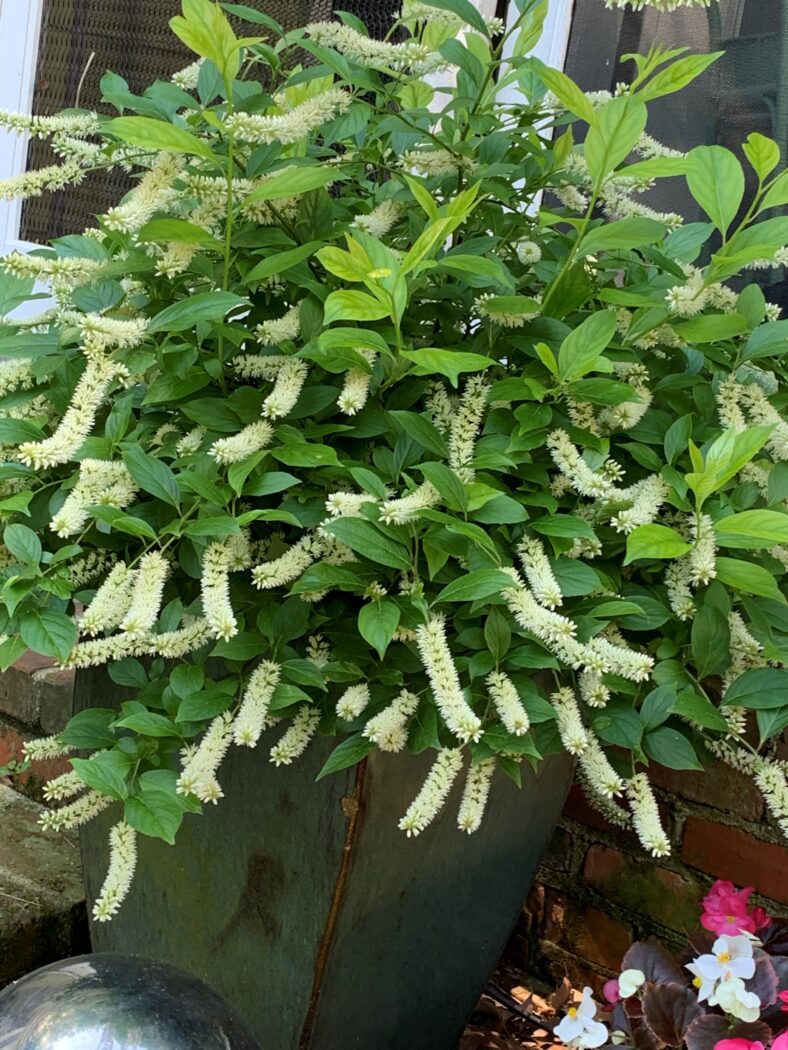When Early Summer Weather Drives You Crazy
Turn Your Attention to the Plants That Bring You Joy
It’s the month of June. The month, in Zone 7, of wide temperature swings. The month in which periods of cold rain are followed by days of drought and unbearable heat; when gardeners complain that it’s too cold to work one week and too hot to be outside the following one. All gardeners in all zones have a month like this when the weather enters an awkward adolescence and tries out personality after personality until it finds one that suits it. It’s part of the thrill of the high wire act of gardening. So, rather than discussing the week-to-week adjustments in approaches we gardeners must make during these annual awkward days, I thought I’d focus on a few of the plants that have made themselves known during these early summer days, plants that remind me why I garden.

Clematis Roguchi
I planted Clematis Roguchi (USDA hardiness Zones 4-8) last year, having heard it praised on Let’s Argue About Plants, a podcast I listen to regularly. I was thrilled by the show the plant put on in its first year; I’m even more delighted during Year Two. Clematis Roguchi isn’t a typical Clematis, one of those showy vines that produce large wide-open flowers for a week or two each year and then sits quietly and unnoticed for the rest of the time. The flowers of Clematis Roguchi – which are a beautiful violet-blue — are much smaller than typical Clematis flowers and are bell-shaped rather than, well, flower-shaped. The small size of the flowers does nothing to minimize their impact, though, as they are borne in great profusion all season long. The vine seems to have boundless energy to just keep pumping out wave after wave of the delightful bluebells, which are replaced by fluffy seed heads, which have their own unique beauty.
Clematis Roguchi grows 6’ – 9’ tall and 2’ – 3’ wide and is one of the leaning/rambling types of Clematis. They don’t have tendrils that grab onto things, so they must be given a bit of support. One option would be to plant Clematis Roguchi next to a rosebush or some other shrub into which the vine can ramble and intertwine its flowers with those of the rosebush. I stapled a sleeve of chicken wire onto the back of my lamp post and around the Clematis. The wire provides support to the bottom 4” of the plant before allowing it to sprawl a bit at the top. The chicken wire disappears once the vine gets growing. It’s a great plant. If you can find one, buy one.
‘Colorado’ Water Lily
The single water Iily I have growing in my garden is, by far, the one plant I have that brings me the greatest joy – and it’s a joy that comes at a reasonable price (around $20!) and with a minimum of fuss and effort.

I know it sounds like an exotic thing to have, but there couldn’t be anything easier than growing a water lily. You stick it in a pot and you put the pot in a 24” deep pool. And that’s it! You don’t even have to remember to water it. I chose Nymphaea “Colorado” (USDA hardiness zones 4a – 10a) because I wanted a water lily that is hardy in my Zone 7 garden and I wanted a water lily that produces flowers above the waterline. The little pool in which I planted my lily is far from the porch and patio on which I often sit and I wanted the lily blooms to be visible from them. Many water lily flowers sit flat on the surface of the water. I but wanted a plant that produced flowers above the water line so they could be seen from where I’d most likely be sitting and Colorado ticked both boxes. Plus, I love the gorgeous mix of sunset colors in the salmon flowers.
In spite of what you may have heard, water features do not have to be that complicated to create or difficult to maintain. The pool in which I have my water lily is a simple, round, pre-formed plastic pool I bought at my local big box store. Sure, it took a bit of digging to bury the thing, but it wasn’t that hard to do. Then, it was just a matter of hiding the edge with a ring of flat stones, dropping in the water lily pot, and filling the thing. A simple recirculating pump with a filter keeps the water moving to prevent mosquitos from breeding on the water’s surface. (Some water lilies dislike being in running water, so try to keep the water movement to a minimum).
Expert Tip: The one recurring maintenance problem – the growth of algae that grew inside and blocked the clear tube that sends water from the filter up to a bronze crane fountain I had placed to one side of the pool – was finally corrected when I replaced the clear tubing with solid black tubing. If sunlight can’t get into the tubing, algae can’t grow there and stop the flow of water. If you don’t want to dig, there are lots of great containers you can purchase for above-ground water features. I have a galvanized livestock water tank on my back patio that is home to a sturdy stand of water grass. Livestock water tanks are easily found at any farm or livestock goods store and they lend a great contemporary/industrial/rural (how’s that for a combination?) feel to the landscape. If you don’t have a lot of space for a water feature, look online for pygmy water lilies. These diminutive and adorable plants just need a bowl full of water to make themselves at home.
Little Henry Dwarf Sweetspire
Another plant that has thrilled me this spring is Little Henry Dwarf Sweetspire (Itea Virginia ‘Sprich’) (USDA hardiness zones 5 – 9). Last year, lured by the photo of the flowers on the plant label, I made an impulse buy and purchased this plant to place in a container by my back door. The purchase was made long after the plant’s spring blooming period, so my experience of this plant has largely been enjoying its compact mounded habit and bright, glossy green leaves during the summer – and then its gorgeous red fall foliage. Even leafless and dormant, the plant is lovely, with a branch structure that is delicate and somewhat pendulous. Even without seeing it bloom, it was a rare impulse purchase I never regretted.

And then spring arrived and the plant was smothered with 3”-4” long catkins of fragrant white blossoms. The scent is slight and not overpowering and the flower petals are minuscule, almost the size of eyelashes, which means most get carried away by the wind and there was no mess to clean up when the plant was done flowering (after several weeks) and it dropped its enormous freight of beautiful flowers. Such an improvement over the double camelia that used to stand nearby. Its flowers were gorgeous, but the slimy, slippery mess that resulted when the petals dropped was a health hazard.
It’s so nice to be able to walk up to my back step and enjoy the four-season beauty of Little Henry Dwarf Sweetspire and not have to keep my eyes glued to the patio in fear of my life. So, if your local weather is going through its own form of adolescent rebellion, swinging from mood to mood and temperature to temperature, don’t lose heart! Just focus on the plants that bring you joy. The weird weather won’t last long, but the joy sure will.

ABOUT THE AUTHOR
Barry Goodinson is an amateur gardener who tends to his Zone 7 garden in southern Delaware on the Atlantic coast of the United States. He has spent his career working with non-governmental organizations focusing on issues such as homelessness, HIV/AIDS, urban green space improvement, and historic preservation. He has an undergraduate degree in philosophy, a master’s degree in public policy, and a certificate in landscape design.
GIVE YOUR FAVORITE PLANTS 5-STARS
Document all you plants in Garenize by adding your own photos and notes, and mark your favorites with 5-stars. This way you can easily go back and check which ones you like the best. Plant by plant, photo by photo you will have a complete personal garden library!
You can download Gardenize from the App Store or Google Play, or log in to the web.
You can find more information on our website Gardenize.com.

More from Gardenize
